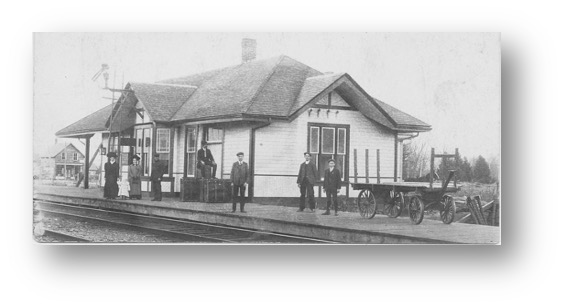Click to Download the PDF
Download the Word Doc
President’s Message
Welcome to the May 25, 2022 edition of the Georgina Historical Society Newsletter. Wow, for the second month in a row we were able to hold a General Members Meeting! It was great to welcome so many enthusiastic members to our meeting and to hear a very interesting talk from our fellow member, Sally Krigstin on “Trees, Wood & Culture”. A great look at some woods whose unique characteristics lend themselves to important cultural applications. Samples were passed around so members could see and feel the great diversity of the many woods. Many thanks to the members who helped make the evening such an enjoyable experience.
Our next General Meeting will be held on the 3rd Tuesday in June, June 21 at the Pioneer Village. It will include a tour of the Village, including the rebuilt schoolhouse, the rejuvenated caboose, the renewed radial stations, descriptive signage, as well as many other Village upgrades. As June 21 is also National Indigenous Peoples Day it would be an excellent time to wear those “Orange Every Chid Matters” T-Shirts that you purchased last year. We must remember our history so we do not repeat our mistakes.
We still are in need of volunteers to help on Canada Day, Sutton Fair, Harvest Day , always an enjoyable time. Contact any board member if you would be able to help.
Looking forward to seeing you at our June meeting…take care, stay safe.
Tom Glover, President
Georgina Pioneer Village’s One-Horse Open Sleigh by Paul Brady

A little horse drawn cutter sleigh has found it’s way into my workshop. It has been in the artifacts collection of the Georgina Pioneer Village since 1978 and was donated by Mrs. R. L. Laidlaw of Willowdale, Ontario. It’s been in storage in the train station at the Village for many years and it took my eye during a visit to the Village on other matters. I asked about it, and museum curator Melissa Matt informed me that the cutter was slated to be a part of the new transportation exhibit planned for the train station.
In addition, they provided a farrier service where working animals were prepared and shod with horseshoes to protect their hooves. As a result, the blacksmith was a key personage in his community.
Blacksmithing has changed greatly over the last 200 years, from a necessary skill to an artisanal craft.
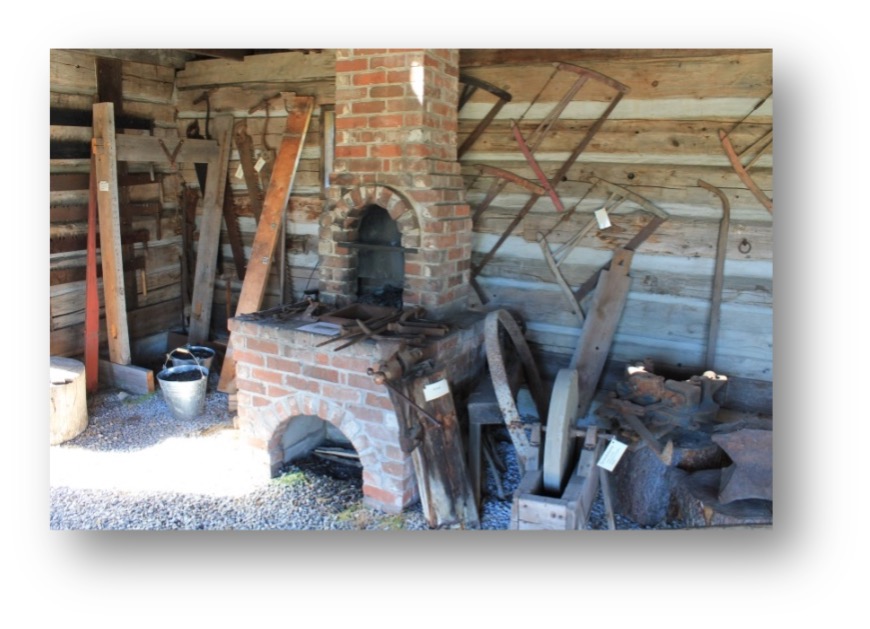
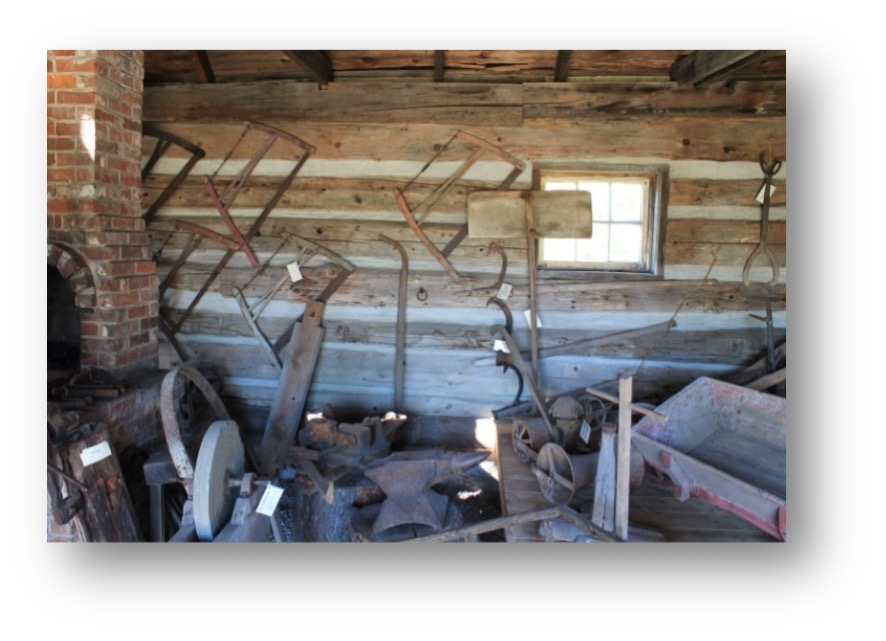
The period before industrialization was a golden age for Canadian blacksmiths due to the demand for metalwork in newly developing communities. Blacksmiths created essential tools and hardware for building homes and fine-tuning transportation, like wagons and horses. A blacksmith would often be found working closely with wheelwrights and wagon makers, sometimes even in the same or adjacent shops.
By the late 1800s, the mass production of factories permitted faster and more cheaply made metal products, threatening the blacksmith’s livelihood. Blacksmiths had to adapt by focusing their attention on shoeing horses and repairing wagons. Wooden wheels were replaced by forged iron wagon wheels as they were more reliable for transport. With their expertise and skills, most smiths maintained a level of prestige as skilled tradesmen within the transportation industry right into the twentieth century.
Modern blacksmiths today keep traditional techniques alive by focusing primarily on artisanal work. Though the fundamentals of blacksmithing remain primarily unchanged over the last 200 years, they have adapted to incorporate modern improvements in tools, such as power hammers, electric powered machinery, and modern torches for heating.
Interior images on this and the previous page are of the blacksmith shop in Georgina Pioneer Village taken by R. W. Holden September 14, 2019.
Blacksmithing – Some Tools of the Trade
The first things you need to be familiar with when it comes to blacksmithing are the tools and their various applications. Here is a list of some of the most common terms you will run into in a blacksmithing business:
Anvil
A blacksmithing anvil is a large block of iron or steel with a flattened top surface. A blacksmith places the metal they are working with on top of the block to be hammered and formed. The anvil is made up of several different working areas, including the horn, the face, the hardie, the pritchel, the neck, and the feet. All these areas can be used to work the metal into different shapes, such as a curve with the neck.

Chisel
A chisel is used to chip, nick, or split away at delicate portions of a piece or metal or other material.
Crucible
A crucible is a ceramic or metal container in which metals or other substances may be melted or subjected to very high temperatures.
Files, grinders, and rasps
Files are used to shape and finish metalwork. Varying from coarse to fine cuts, they come in many sizes and in flat, half round, or round shapes. Rasps have the coarsest cut of all and are used primarily for shaping animal hooves for shoeing and other work involving non-metallic surfaces. Grinders are abrasive stone wheels, usually powered by hand or foot, that shape, sharpen, or polish metal finishes.
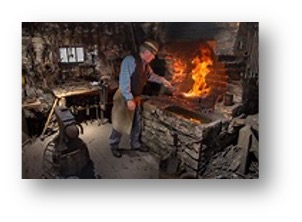
Forge
The forge is fueled by strong flames to heat metal and other materials. A blacksmith places metal into the forge to make it more malleable and shapeable later on the anvil.
Hammer
Hammers are the most prominent tools of a blacksmith and are used to repeatedly hit materials in order to give them their shape. There are several different types of blacksmithing hammers, including a cross peen, straight peen, rounding, flatters, set hammers, and more.
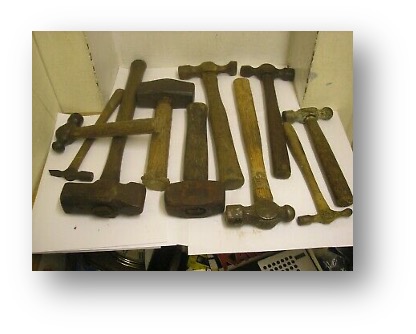
Punch
A punch is a metal tool that is used with a hammer to punch holes in metal or to drive rivets. Today punches can also come in an automated machine variety, though this is more often seen in metalworking than blacksmithing.
Tongs
Tongs are what the blacksmith uses to hold and transport extremely hot materials from the furnace to the anvil and elsewhere around the working space.
Vices and Clamps
Vices and clamps are what a blacksmith uses to hold a piece of metal or other material while hammering, chiseling, or generally working on it.
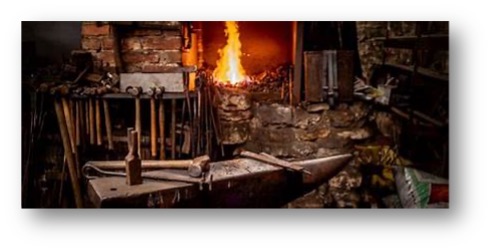
Processes Used in Blacksmithing
With a basic understanding of some of the tools blacksmiths must use, let’s have a look at the actual smithing processes. These are the ways that a blacksmith uses their tools to shape metal and other materials. In the daily business or training of a blacksmith, these are most of the basic tasks he or she must encounter and perform in his or her (…women are now employed in what was once a male preserve) work.
Bending – Bending is the process of forming a curve or a bend in a piece of metal. This is done by heating the piece of metal and hammering it over the horn of the anvil.
Casting – Casting is the process of pouring metal that has been heated to a liquid into a mold to form a shape or bar.
Drawing Out – Drawing out a piece of material means making it longer. The blacksmith could also make it thinner or wider, depending on the desired results.
Finishing – Finishing is the process of working a metal or other material into its final shape. Finishing includes polishing and putting all the final touches on the product.
Forging – Forging is the entire process that a blacksmith deals with to work heated metal into the desired shape.
Hammering – Just like it sounds, hammering is the process of a blacksmith striking a piece of material with any various kinds of hammer repeatedly to form a desired shape.
Quenching – Quenching requires a blacksmith to rapidly cool a piece of heated material by means of exposing it to water, air, or oil. Quenching is typically done to harden metals like steel.
Shaping – Shaping is the process of hammering, bending, and otherwise working with a piece of metal or other material to change its form.
Smelting – Smelting involves extracting metal from ore. This requires the material to be heated in order to melt and separate the metal from the ore.
Soldering – Soldering is the process of connecting two pieces of metal or other material at a joint. These pieces are connected by a melted filler metal with a lower melting point than the connecting pieces.
Tempering – Tempering is the process of hardening a metal by reheating and quickly cooling it. This process helps increase the toughness of a metal.
Upsetting – The opposite of drawing and drawing out, upsetting is a technique used to make the working metal shorter, thicker, or narrower.
Welding – Welding is the process of joining two pieces of metal by heating them near melting point and hammering them together. These metals, unlike soldering are heated and connected themselves rather than using a filler metal to connect them.
Today
Modern blacksmithing has largely evolved into an artisan craft producing primarily specialty and custom work while the more traditional labour with animals has been left to specialists in the trade called farriers. With access to power tools and modern technology, a blacksmith’s work is a little less physically demanding than it was in the past. Though still a predominantly male preserve, it is also drawing many women into the trade especially in the artisanal and craft side of the work.
Information on tools and processes from: https://castmastereliteshop.com/blogs/news/a-glossary-of-blacksmithing-terms
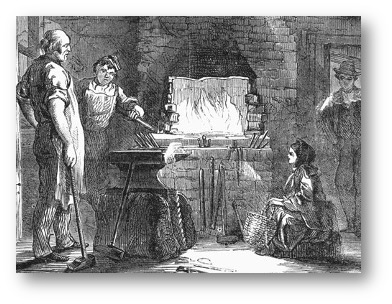
Blacksmiths Forge, 1862 is an image by Granger uploaded from https://www.walmart.com/ip/BlacksmithS-Forge-1862-Nwood-Engraving-American-1862-Poster-Print-by-Granger-Collection/181498620
Our Communities – Pefferlaw
Pefferlaw was founded in the late 1820s by Captain William Johnson; a British Naval Officer who was released from service in 1815 following the Battle of Waterloo. The name, Pefferlaw, was suggested to Captain Johnson by his brother in remembrance of a field among the heather on their old homestead and means, “a beautiful greensward.” The first preserved diaries of William Johnson begin in 1832. By that time he had built a sawmill, woolen mill and gristmill at Pefferlaw. The first store in the village of Pefferlaw was built in August 1833. Soon after, Robert Johnson, brother of William, took over running the store and shortly thereafter built a large two-story red brick house on the edge of the bank beside the store which still stands today. The second store in Pefferlaw was built by George Johnson, son of Captain William, this in 1856.
Banking came to Pefferlaw with the arrival of the C.N.R. Railway in 1906. Pefferlaw station was built in 1906 by the Canadian Northern Railway along their line between Toronto Union Station and Sudbury. (see station image – right) Bankrupt in 1918, the entire system was integrated into the Canadian National in 1923 and continued to operate the station until the mid-1960’s when passenger service ended. The station was demolished in 1977.
he Pefferlaw area like all early hamlets had its share of hotels – one at every crossroad. The Morning Glory Hotel was built in the 1860s and stood for many years on the site of the present day Morning Glory Public School. The tavern was well patronized by river drivers, lumber workers and stage coach passengers and drivers. The Mansion House Hotel was built in 1884. When it changed owners in 1906 the establishment was renamed, Hotel Belvedere (see left).
Captain Johnson died in 1851 at “Oldcastle”, lot 6, conc. 7, Georgina, which was always his home. He is buried there. ***
***Adapted from – https://en.wikipedia.org/wiki/Pefferlaw,_Ontario
Memories of Hired Help on the Farm ~ By Tom Glover
Here’s a few of my memories of some of the many hired hands on our farm in the forties and fifties!
Frank & Hendrika “Our First Dutch Family”
After the war, Mom and Dad applied to sponsor a Dutch immigrant family. They were to provide a home and a job and the immigrant family in return were to spend their first 2 years in Canada on our farm. As they were required to provide a home for the immigrants Dad build a new house for the family across the road from our home. They were expecting a family of 7. However, there was a change in plans; a family of 13 who were to go to a farm in Chatham suddenly needed a new sponsor. Would the Glovers accept them? It would be a tight fit in the small house Dad built, but of course my parents would not say no.
Soon, word came that they were to arrive at Zephyr station. Dad in the old Ford car and Uncle Lea in his pick-up truck arrived at Zephyr to find the train stopped and the Van Bakel family waiting on the platform. The conductor told my father that they were not going to leave the Dutch immigrants alone at the station and would have held the train as long as it took for him to arrive.
There had been no time to stock the cupboard in their new home and the next morning mother cooked breakfast for the family of 13. My sister, brother and I were told not to stare at our guests; however our eyes were glued to the windows as the Van Bakels crossed the road and walked up the lane to our home. Mom cooked all the oatmeal she had on hand and when that was gone she brought out the Glover specialty…”Cornflakes.” The Dutch family had never seen Cornflakes, they smiled and giggled when they touched them with their spoons and then they devoured this newly discovered food.
Cornflakes were to become a favourite Canadian treat.
Only one of the daughters spoke any English at all, and she accompanied father to the local general store where he bought them the groceries they needed. There was a great deal of excitement when 2 large shipping crates with the families’ possessions arrived.
Much laughter and cheerful voices were to be heard as the crates were unpacked. A large mound of wooden shoes grew on the ground as the families’ foot wear was handed down from the container. Mom and dad soon noticed that Mrs. Van Bakel seemed very sad and cried a lot. Wishing to help, but not being able to communicate very well dad sought the assistance of another Dutch immigrant who was fluent in English. Apparently, before boarding the ship, the local priest had warned her to be sure that the family attended church in Canada or they would all be going straight to Hell. On hearing this father and uncle Lea took them to Keswick to mass every Sunday until Frank was able to purchase and learn to drive his own car.
Frank was paid $75 per month, a house rent free, and all the milk and eggs they needed.
Four of the older children went to neighbouring farms where they would work for room and board and learn English and the Canadian way of life. Harry went to work for Russell and Betty Pollock at Ravenshoe for $45 a month and room and board. Marie went as a mother’s helper to the Mahoneys and was also paid $45 per month and room and board.
Toni and John went to Uncle Charlie and Aunt Marjorie Haines at Sharon.
Toni received $25 per month and 13 year old John $15 as well as room and board.
Mom and dad only arranged for them go to work on farms where they knew they would be well treated.
The oldest daughter, Corrie and her husband, Ted Brouwers also immigrated to Canada and they travelled to Ottawa to work on a farm there. Soon Frieda’s fiancé’, Jeff Gerrits arrived, bringing with him a gift of pots and pans for his bride to be. They married and moved to the “Beech Farm”, owned by Uncle Lea to begin their new life together. Marines, Nick, Marty and Theo attended school with Louise and Richard in the one room school house at Mount Pleasant. I would often cross the road and call, “Commas Riekie! Commas Fransien!” …my invitation to the younger girls to come out and play. One day while cutting cedar posts in the bush, the Case tractor tipped over pinning dad beneath the Sedore loader’s frame. Frank excitedly asked in his broken English “What I do Carl? What I do?” Dad pointed out a pole that Frank could use as a lever and he was able to raise the loader enough for father to drag himself out.
Frank’s sons remember their dad coming home one evening and entertaining them with a tale of “the skunk chase”. They were leaving the wood lot at the ranch and crossing the pasture field when father spotted a skunk. He immediately tramped the accelerator on the old army truck and attempted to run down the skunk. As the skunk dodged and ran, Dad would quickly maneuver the truck in an attempt to hit it. Finally the skunk escaped and seeing the smile on dad’s face Frank realized his employer had not turned into a madman but was providing a little “fun” after a hard day’s work.
During their second year at the Glovers’, Frank got the opportunity of a job on the Catholic farm south of Newmarket. It came with a much larger house, better to accommodate the family and was nearer to fellow Dutch immigrants and a Catholic Church. On a cold snowy March day they said good bye and with mixed emotions set out on the next step of their Canadian journey. My parents had a great deal of respect for Frank and Hendrika for having the courage to abandon their life in Holland and come to Canada in search of a better future for their family. They did everything possible to assist them and their children with their transition from humble immigrants to successful and proud Canadians. A strong friendship developed between our families that remains to this day. We were pleased to attend their family celebration of 40 years in Canada.
Just how much my parent’s friendship and assistance meant to the Van Bakels was relayed to me in the mid-1990s. I was introduced to another post war immigrant who asked if I was Carl and Helen Glover’s son. When I replied that I was, a big smile appeared on his face as he enthusiastically shook my hand and said “All us Dutch Canadians know about the Glovers.” Unfortunately not all of the immigrants had experienced the kindness and support that my parents had given to the Van Bakel family.
Derringer Bob
Dad always hired a neighbour to bale our hay as he figured our time was better spent getting the hay into the barn then doing the baling. His friend’s 20 year old son often came to bale the hay. Bob, liked guns and he would bring his 22 rifle with him, if he spotted a groundhog in the field he would grab the rifle and shoot it. Imagine my mom’s horror when one day at supper he pulled a derringer out of his pocket and passed it around for my father, brother and me to admire. He proudly announced that would no longer need to bring his 22 rifle as the derringer was much more convenient for him to have on the tractor. From that day on we called him Derringer Bob and mom forbid us to start hauling in the hay until he had left the field and headed home.
Joe
For odd jobs around the farmstead Dad would hire Joe. Joe was the first person I ever saw who had hearing aids. Two plugs hooked over his ears with the attached wires running to the receiver in his shirt pocket. He never seemed to let this inconvenience bother him and always had a smile and was quick to chuckle. I think of Joe when people complain about the inconvenience of hearing aids. Joe liked a good cigar and would enjoy it in its entirety. When the cigar got down to the stub Joe would flick the ashes off the end, peel back the remaining wrapper and place the remaining tobacco in his mouth. Nothing like a good smoke and chew!
Our Pioneer Ancestors
ROBERT RIDDELL, lot 1, concession 5, is a native of the Parish of East Kilbride, Lanarkshire, Scotland, and to Canada in the year 1829. On his arrival he located in the County of Harlington, Quebec Province, where he remained about ten years, after which he took up his residence in Montreal and worked for the Hon. John Molson. The cholera being very bad, Robert took his departure from Montreal and came west to Dundas, where he stayed until the fall of 1834, when he came to Georgina Township and located on the farm where he now resides. He was married in Toronto in the latter part of 1834, his wife s maiden name being Elizabeth McConachie; they have six children all living. In the early days of settlement they had to carry grain on their backs to Sutton to be ground.* *Excerpted from: History of Toronto and County of York, Volume II; C. Blackett Robinson, Publisher 1885, p. 511Where in Georgina?
Unsolved as yet…here again is our current mystery place; what and where is the location of the above image? Hint…it’s still there…as a private residence!
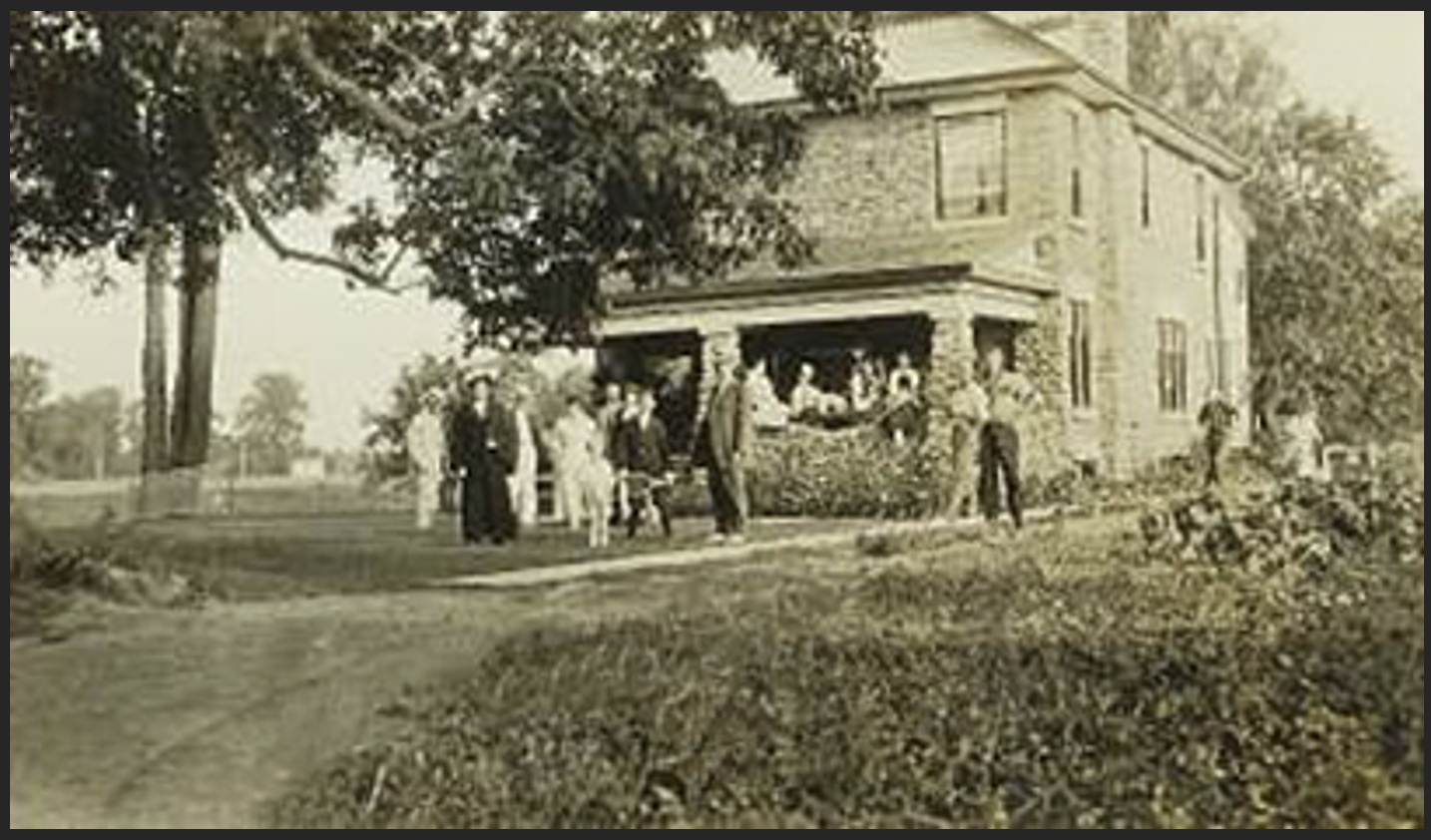
News
Good News!! The adaptive reconstruction of the Cedarbrae Schoolhouse is almost completed and at our May general meeting, we may be able to use it for our general meeting venue so that the membership can have a preview peek at it.
With everything opening up, the GHS will need all hands on deck to help with events and in preparing the Village for its projected opening of June 4th. If you can help or would like more information, please contact Melissa Matt, Curator of Georgina Pioneer Village, at 905-476-4301 ext. 2284 or curator@georgina.ca. For all other events or queries contact a GHS Board member for further information. Handouts will be distributed at the Program Meeting on April 19th advising members attending of upcoming meetings, their topics, other events and upcoming volunteer opportunities in the Village. They will also be advised of this information in future issues of the newsletter.
Help! Finally, we’d like to appeal to the membership, friends, and family members for any interesting anecdotes or stories of the past and old photos or images that might be shared with the membership. Over time these recollections get lost and should be written down or recorded in some manner and archived for future generations so they might learn more about our past.
A reminder of the General Meeting of the Georgina Historical Society on Tuesday, April 19 at 7:00 pm at De La Salle Hall. The topic is “Bring and Brag” so please bring old photos, documents or an article from the past to share with your fellow members. It is always an interesting and enjoyable evening sharing articles and stories and a great way to get back together again.
Events
May 17th – Sally Krigstin – Wood and Its Uses Through the Ages May general meeting possibly at the rebuilt schoolhouse…more info to come!
June 4th – Tentative opening of Georgina Pioneer Village…volunteers wanted to get the village ready and to help out at the opening.
June 21st – Tour of the new schoolhouse, renovated Caboose, and new Village signage.
July 1st – Canada Day at the Pioneer Village…volunteers needed
August 5th, 6th, and 7th – Sutton Fair 1st weekend in August volunteers need for our booth.
September 17th – Harvest Day at Georgina Pioneer Village…help needed here too!

